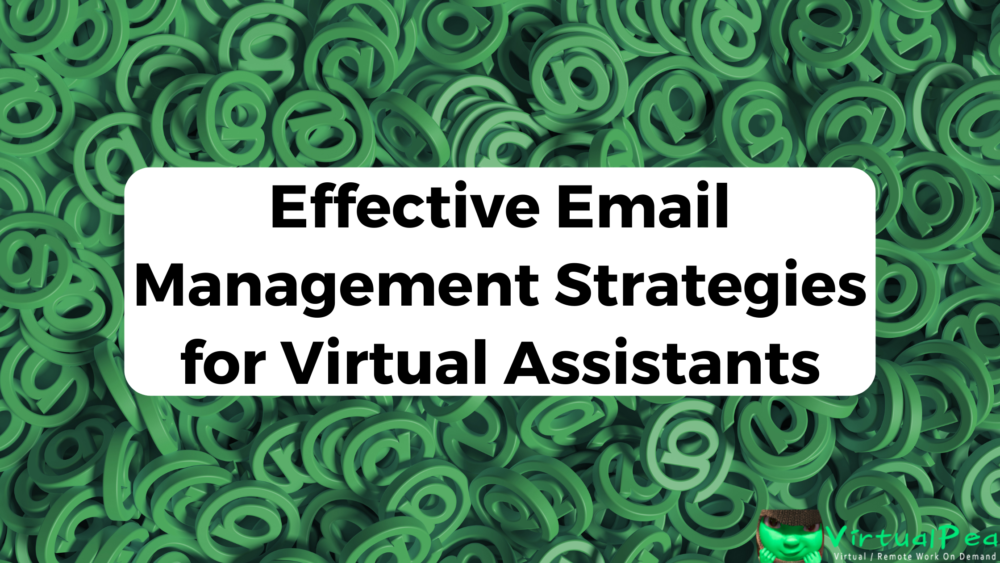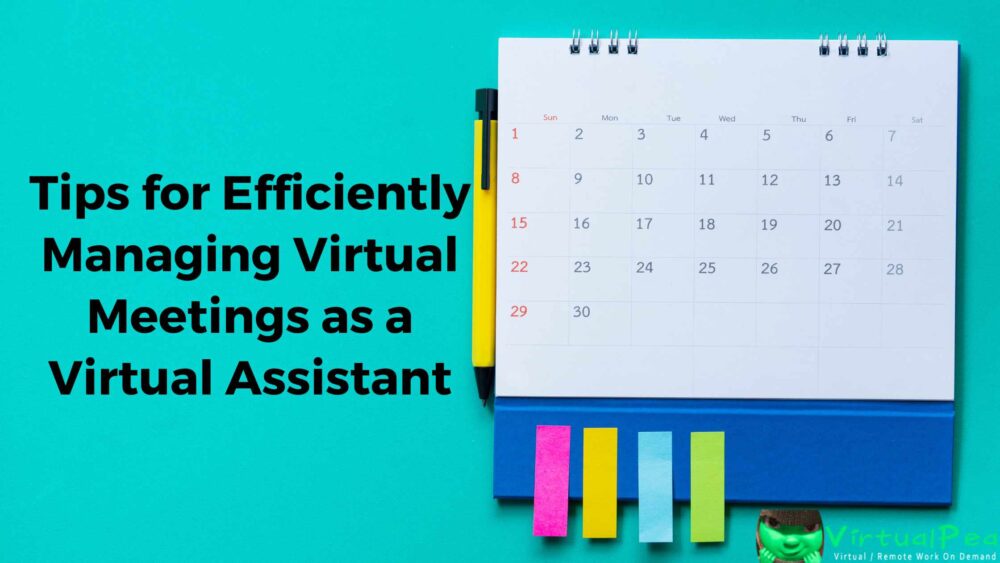
Client onboarding is a crucial process for virtual assistants as it sets the foundation for successful partnerships and long-term client relationships. Effective onboarding strategies ensure that both parties have a clear understanding of expectations, goals, and workflows. In this article, we will explore key strategies to help virtual assistants onboard clients effectively and establish strong partnerships.
1. Clear and Transparent Communication
Clear and transparent communication is essential during the client onboarding process. Set the tone by promptly responding to inquiries, providing detailed information about your services, and addressing any concerns or questions they may have. Establish open lines of communication through email, phone calls, or video conferences, and ensure that both parties have a clear understanding of how to communicate throughout the partnership.
2. Define Expectations and Goals
During the onboarding process, clearly define expectations and goals with your clients. Discuss project scope, timelines, deliverables, and any specific requirements. Understanding their objectives will help you align your work accordingly. Document these details in a comprehensive onboarding document or agreement to avoid any misunderstandings and ensure a smooth collaboration.
3. Establish Workflows and Processes
Establishing workflows and processes is crucial for a successful partnership. Determine how tasks will be assigned, shared, and tracked. Define communication channels, file-sharing methods, and project management tools that will be used. By setting up a streamlined workflow from the beginning, you can save time, reduce confusion, and maintain transparency throughout the collaboration.
4. Build Rapport and Trust
Building rapport and trust with your clients is vital for long-term success. Take the time to understand their business, industry, and unique needs. Show genuine interest in their goals and challenges. Personalize your communication and find common ground to establish a connection. Building rapport and trust early on fosters a positive working relationship and encourages open collaboration.

5. Provide a Welcome Packet or Onboarding Guide
Offering a welcome packet or onboarding guide can be immensely helpful for clients. This document should provide an overview of your services, your work process, communication channels, and contact information. Include details about billing, invoicing, and any other administrative processes. A comprehensive welcome packet ensures that clients have all the information they need to start working with you seamlessly.
6. Set Realistic Timelines and Expectations
When onboarding clients, it’s essential to set realistic timelines and expectations. Be transparent about your availability, turnaround times, and any potential limitations. Avoid overcommitting and provide realistic estimates for project completion. This helps manage client expectations and prevents disappointment or dissatisfaction down the line.
7. Conduct Regular Check-ins
Regular check-ins are crucial during the onboarding phase and beyond. Schedule periodic meetings or calls to discuss project progress, address any concerns, and ensure that both parties are aligned. These check-ins demonstrate your commitment to their success and allow for ongoing feedback and adjustments, promoting a collaborative and productive relationship.
Effective client onboarding strategies are key to establishing strong partnerships as a virtual assistant. By emphasizing clear communication, defining expectations, building rapport, and setting realistic timelines, you can create a solid foundation for successful collaborations. Invest time in the onboarding process to understand your clients’ needs and ensure a smooth workflow. By prioritizing effective client onboarding, you can set the stage for long-term client relationships and foster mutual success.

Project management methodologies play a crucial role in the success of virtual assistants. These methodologies provide structure, organization, and efficiency to the workflow, ensuring that tasks are completed on time and with optimal results. In this blog post, we will explore the role of project management methodologies for virtual assistants and how they can help streamline your workflow and boost your efficiency. We will specifically focus on popular methodologies like Agile and Waterfall and their applications in the virtual assistant industry.
1. Agile Methodology for Flexibility and Adaptability
Agile methodology is known for its flexibility and adaptability, making it an ideal approach for virtual assistants. It emphasizes iterative and incremental progress, allowing for frequent communication and collaboration with clients. By breaking down projects into smaller tasks called sprints, virtual assistants can deliver incremental value and receive continuous feedback, enabling them to adapt and refine their work as needed. Agile methodology empowers virtual assistants to quickly respond to changes and deliver high-quality results.
2. Waterfall Methodology for Structured Planning and Execution
Waterfall methodology is a sequential approach that follows a linear progression from one phase to another. It is characterized by detailed planning and a clear project roadmap. Virtual assistants can benefit from the Waterfall methodology by breaking down projects into distinct stages and executing them in a step-by-step manner. This approach ensures that each phase is completed before moving on to the next, reducing the risk of errors or missed deadlines. Waterfall methodology provides structure and clarity, enabling virtual assistants to manage projects efficiently.

3. Hybrid Methodologies for Customized Workflows
In addition to Agile and Waterfall, virtual assistants can also adopt hybrid methodologies that combine the best aspects of multiple approaches. Hybrid methodologies allow for customization based on the specific needs of the project or client. By blending different project management techniques, virtual assistants can create a workflow that aligns perfectly with their working style and project requirements. This flexibility enables them to optimize their productivity and deliver exceptional results.
4. Task Management and Collaboration Tools
To effectively implement project management methodologies, virtual assistants can leverage task management and collaboration tools. These tools enable efficient task tracking, scheduling, and collaboration with clients and team members. Project management software like Asana, Trello, or Monday.com provides a centralized platform for organizing tasks, setting priorities, and monitoring progress. By utilizing these tools, virtual assistants can enhance communication, foster collaboration, and stay on top of their projects.
Project management methodologies play a vital role in optimizing workflows, enhancing task management, and improving overall efficiency for virtual assistants. Whether you choose Agile methodology for its flexibility and adaptability, Waterfall methodology for structured planning and execution, or a hybrid approach that suits your specific needs, implementing these methodologies can significantly enhance your productivity and deliver exceptional results. Additionally, utilizing task management and collaboration tools empowers virtual assistants to streamline their workflow, communicate effectively, and stay organized. By leveraging project management methodologies and tools, virtual assistants can provide stellar administrative support and exceed client expectations.

As a virtual assistant, your time is valuable, and finding ways to streamline your workflow and increase efficiency is essential. One powerful solution is leveraging automation tools. By automating repetitive tasks and optimizing your processes, you can free up time for higher-value activities and enhance your overall productivity. In this article, we will explore the benefits of automation and provide practical tips on how to leverage automation tools as a virtual assistant.
1. Identify Repetitive Tasks
The first step in leveraging automation tools is identifying the repetitive tasks that consume a significant amount of your time. This could include tasks like email management, data entry, social media scheduling, or file organization. By recognizing these repetitive tasks, you can prioritize them for automation and focus on more strategic responsibilities.
2. Research and Select Automation Tools
Once you’ve identified the tasks you want to automate, research and select the appropriate automation tools. There is a wide range of tools available, catering to different aspects of virtual assistant work. Some popular automation tools include task management platforms, email filters and templates, social media schedulers, and document automation software. Consider your specific needs and choose tools that integrate well with your existing workflow.
3. Streamline Email Management
Email management is often a time-consuming task for virtual assistants. To streamline this process, use automation tools to categorize and filter incoming emails, set up canned responses for common inquiries, and schedule email delivery at optimal times. Additionally, consider using email tracking tools to monitor email open rates and prioritize follow-ups.

4. Automate Social Media Scheduling
Managing social media accounts is a crucial aspect of many virtual assistant roles. To save time, leverage automation tools that allow you to schedule posts in advance across different platforms. Tools like Hootsuite, Buffer, or Sprout Social enable you to plan and schedule social media content, ensuring a consistent online presence without the need for manual posting.
5. Use Task Management Tools
Task management tools are essential for organizing your workload and collaborating with clients or team members. Platforms like Trello, Asana, or Monday.com offer features such as task assignment, due date tracking, progress monitoring, and file sharing. By centralizing your tasks and automating reminders, you can stay organized and ensure nothing falls through the cracks.
6. Implement Document Automation
Creating and managing documents is a common task for virtual assistants. To streamline this process, consider using document automation tools like Google Docs, Microsoft Office templates, or specialized document automation software. These tools allow you to create reusable templates, automate formatting, and collaborate with clients or colleagues in real-time.
Leveraging automation tools as a virtual assistant can significantly enhance your productivity and efficiency. By identifying repetitive tasks, researching and selecting the right automation tools, streamlining email management, automating social media scheduling, using task management platforms, and implementing document automation, you can optimize your workflow and focus on high-value activities. Embrace automation as a virtual assistant and unlock your full potential.

In today’s fast-paced business landscape, many companies are turning to virtual assistants as a strategic outsourcing solution. Virtual assistants, skilled professionals who work remotely, offer a range of services and expertise to support businesses across various industries. Outsourcing to virtual assistants brings numerous benefits, including cost savings, scalability, task delegation, and access to specialized skills. In this article, we will explore the advantages of outsourcing to virtual assistants and how they can help businesses boost efficiency, increase productivity, and achieve sustainable growth.
1. Cost Savings
Outsourcing to virtual assistants can significantly reduce operational costs for businesses. Virtual assistants typically work on a contract or project basis, eliminating the need for full-time employees and associated expenses like salaries, benefits, and office space. By outsourcing tasks to virtual assistants, businesses can access top talent without the overhead costs, making it a cost-effective solution for administrative, creative, or technical support.
2. Scalability
Virtual assistants offer businesses the flexibility to scale their operations up or down based on demand. Whether you need temporary support during busy periods or ongoing assistance, virtual assistants can adapt to your changing needs. You can easily adjust the number of virtual assistants or the scope of their responsibilities to match your business requirements. This scalability ensures that you have the right resources at the right time, optimizing productivity and operational efficiency.

3. Task Delegation and Focus
Delegating non-core or time-consuming tasks to virtual assistants allows business owners and their teams to focus on strategic initiatives and revenue-generating activities. Virtual assistants can handle administrative tasks, customer support, data entry, social media management, content creation, and more, freeing up valuable time for core business functions. By offloading these tasks to virtual assistants, businesses can enhance productivity and allocate resources where they are most impactful.
4. Access to Specialized Skills
Virtual assistants often possess specialized skills in various areas, such as graphic design, web development, digital marketing, or content writing. By outsourcing to virtual assistants, businesses gain access to these specialized skills without the need for extensive training or hiring additional employees. This access to expertise enables businesses to deliver high-quality work, stay competitive, and expand their service offerings.
5. Increased Efficiency and Productivity
Virtual assistants are experienced professionals who are accustomed to working independently and managing their time effectively. They bring a high level of efficiency and productivity to their assigned tasks. By leveraging the expertise and work ethic of virtual assistants, businesses can streamline their operations, accelerate project timelines, and achieve faster turnaround times. This increased efficiency ultimately translates into improved customer satisfaction and business growth.
Outsourcing to virtual assistants offers numerous benefits for businesses looking to enhance efficiency, increase productivity, and achieve sustainable growth. From cost savings and scalability to task delegation and access to specialized skills, virtual assistants provide a valuable outsourcing solution. By leveraging the expertise and support of virtual assistants, businesses can focus on core functions, allocate resources strategically, and deliver high-quality work. Embrace the advantages of outsourcing to virtual assistants and unlock the potential for business success in today’s dynamic marketplace.

As a virtual assistant, managing email efficiently is essential for maintaining effective communication with clients and optimizing productivity. With the constant influx of messages, it’s crucial to implement effective email management strategies. In this article, we will explore practical tips and techniques for virtual assistants to manage their emails effectively. From inbox organization to email filtering and the use of email templates, these strategies will help you stay organized, save time, and enhance client communication.
1. Inbox Organization
Start by organizing your inbox into specific folders or categories to easily locate and manage emails. Create folders based on clients, projects, or priority levels. Develop a filing system that works best for you and consistently move emails to their respective folders after processing them. A well-organized inbox ensures that important emails don’t get buried and allows for efficient retrieval when needed.
2. Email Filtering and Rules
Utilize email filtering and rules to automate the organization and management of your emails. Set up filters to automatically sort incoming messages into relevant folders based on criteria such as sender, subject, or keywords. This saves time and ensures that important emails are prioritized. Regularly review and adjust filters as needed to maintain accuracy and effectiveness.

3. Effective Email Prioritization
Prioritize your emails based on urgency and importance. Start by scanning your inbox and identifying emails that require immediate attention or have strict deadlines. Utilize features such as flags or stars to mark important emails for quick reference. Develop a system for categorizing emails based on their priority level to ensure you address critical matters promptly and efficiently.
4. Use Email Templates
Create and utilize email templates for common inquiries, responses, or client communications. Templates can save you time and ensure consistency in your email communication. Customize the templates as needed to personalize the message for each client or situation. By using templates, you can streamline your responses and handle repetitive email tasks more efficiently.
5. Regular Email Maintenance
Schedule dedicated time for email management to avoid becoming overwhelmed. Set aside specific periods throughout the day to process and respond to emails. Avoid constantly checking your inbox, as it can lead to distractions and hinder productivity. Instead, establish a routine that allows you to focus on other tasks and allocate specific time slots for email management.
Effective email management is essential for virtual assistants to maintain clear communication, save time, and optimize productivity. By implementing strategies such as inbox organization, email filtering, effective email prioritization, the use of email templates, and regular email maintenance, virtual assistants can stay organized, enhance client communication, and effectively manage their email workload. Incorporate these practices into your daily routine to streamline your email management process and improve your overall efficiency as a virtual assistant.

As a virtual assistant, effective project management is crucial for delivering outstanding results to clients and ensuring the success of your virtual team. Remote project management requires efficient communication, meticulous planning, and strong organizational skills. In this article, we will explore essential tips for remote project management as a virtual assistant, enabling you to optimize productivity, streamline workflows, and foster seamless collaboration within virtual teams.
1. Establish Clear Project Goals and Objectives
Before diving into a project, it’s essential to establish clear goals and objectives. Collaborate with your client or team to define the desired outcomes, project scope, and key deliverables. This clarity ensures that everyone is aligned and working towards the same objectives, facilitating smoother project execution.
2. Utilize Project Management Tools
Leverage project management tools to streamline workflows, manage tasks, and enhance collaboration. Tools such as Asana, Trello, or Monday.com provide a centralized platform for tracking progress, assigning tasks, setting deadlines, and communicating with team members. These tools promote transparency, accountability, and efficient project management.
3. Define Roles and Responsibilities
Clearly define roles and responsibilities for each team member involved in the project. Establishing who is responsible for specific tasks and deliverables eliminates confusion and ensures accountability. Clearly communicate these roles and expectations to avoid duplication of efforts and ensure efficient project execution.

4. Foster Effective Communication
Communication is vital in remote project management. Establish regular check-ins and team meetings to provide project updates, address any concerns, and ensure everyone is on the same page. Utilize communication tools like Slack or Microsoft Teams to facilitate real-time communication, file sharing, and collaboration. Encourage open and transparent communication to maintain a strong virtual team dynamic.
5. Break Down Projects into Manageable Tasks
Break down projects into smaller, manageable tasks with clear deadlines. This approach helps prevent overwhelm and allows for better tracking and progress monitoring. Use task management tools to assign tasks, set priorities, and ensure timely completion of each task.
6. Set Realistic Deadlines and Milestones
Establish realistic deadlines and milestones for the project. Consider the complexity of tasks, available resources, and potential dependencies. Setting achievable timelines promotes efficiency, minimizes stress, and enables proper planning and allocation of resources.
7. Regularly Evaluate Progress and Adjust
Continuously evaluate project progress to identify any bottlenecks or areas for improvement. Regularly review the project’s status, milestones, and deliverables to ensure alignment with the overall project objectives. Adjust timelines or resources as needed to stay on track and address any challenges that arise.
Effective remote project management is vital for virtual assistants to deliver exceptional results and foster seamless collaboration within virtual teams. By establishing clear project goals, utilizing project management tools, defining roles and responsibilities, fostering effective communication, breaking down projects into manageable tasks, setting realistic deadlines, and regularly evaluating progress, you can optimize productivity and ensure project success. Implement these tips and elevate your remote project management skills as a virtual assistant.

As a virtual assistant, effectively managing virtual meetings is essential for seamless communication and collaboration with clients and team members. With the rise of remote work, virtual meetings have become an integral part of business operations. In this article, we will provide you with valuable tips for efficiently managing virtual meetings as a virtual assistant.
1. Set Clear Objectives and Agendas
Before each virtual meeting, ensure you have clear objectives and create a detailed agenda. Define the purpose of the meeting and outline the topics or tasks to be discussed. Share the agenda with participants in advance, so they come prepared and know what to expect. Clear objectives and agendas help keep meetings focused and productive.
2. Coordinate Schedules Effectively
Virtual assistants often work with clients or team members across different time zones. Efficiently coordinate schedules to find suitable meeting times for all participants. Utilize online scheduling tools or calendar apps that allow participants to view each other’s availability and select a mutually convenient time. Being mindful of time zones helps prevent scheduling conflicts and ensures everyone can attend the meeting.

3. Utilize Reliable Video Conferencing Tools
Choose a reliable video conferencing tool to host virtual meetings. Popular options include Zoom, Microsoft Teams, and Google Meet. Familiarize yourself with the features and settings of the chosen tool, such as screen sharing, recording, and participant management. Test the tool’s functionality before the meeting to avoid technical glitches and ensure a smooth meeting experience.
4. Establish Meeting Etiquette and Guidelines
Set clear meeting etiquette and guidelines to ensure professionalism and smooth communication during virtual meetings. Encourage participants to mute their microphones when not speaking to reduce background noise. Emphasize active listening, respectful communication, and the importance of sticking to the agenda. Establishing guidelines helps maintain order and fosters a positive meeting environment.
5. Utilize Online Collaboration Tools
Enhance collaboration during virtual meetings by utilizing online collaboration tools. Platforms like Google Docs, Microsoft SharePoint, or project management software allow participants to collaborate on documents, share ideas, and track progress in real-time. Encourage participants to use these tools during the meeting to facilitate collaborative work and ensure effective follow-up after the meeting.
Efficiently managing virtual meetings is crucial for virtual assistants to facilitate seamless communication and collaboration. By setting clear objectives and agendas, coordinating schedules effectively, utilizing reliable video conferencing tools, establishing meeting etiquette, and leveraging online collaboration tools, virtual assistants can enhance their meeting management skills. Embrace these tips to ensure productive and engaging virtual meetings that contribute to the success of your work as a virtual assistant.

As a virtual assistant, it’s crucial to prioritize cybersecurity and protect your clients’ sensitive data. With cyber threats on the rise, maintaining the confidentiality and integrity of client information is paramount. In this article, we will explore essential cybersecurity practices for virtual assistants to protect client data. From ensuring secure communication channels to implementing robust password management and data backup strategies, these tips will help you safeguard sensitive information and maintain client trust.
1. Secure Communication Channels
Secure communication is vital for protecting client data. Avoid using unencrypted or public Wi-Fi networks when accessing or transmitting sensitive information. Instead, use encrypted communication tools such as encrypted email services, virtual private networks (VPNs), or secure messaging platforms. Encrypting your communications adds an extra layer of protection and ensures that sensitive data remains confidential.
2. Robust Password Management
Strong and unique passwords are essential to prevent unauthorized access to client data. Avoid reusing passwords across different platforms and use a reliable password manager to securely store and generate complex passwords. Enable multi-factor authentication (MFA) whenever possible to add an extra layer of security. Regularly update and change passwords to mitigate the risk of a potential data breach.

3. Data Backup and Recovery
Implementing a comprehensive data backup and recovery plan is crucial in the event of data loss or cyber attacks. Regularly back up client data to secure and reliable storage solutions, such as cloud-based platforms or external hard drives. Test the restoration process periodically to ensure data integrity. Having a reliable backup strategy minimizes the impact of data loss and enables quick recovery in case of unforeseen incidents.
4. Data Privacy and Confidentiality
Respecting client privacy and confidentiality is fundamental for virtual assistants. Establish clear data privacy policies and obtain client consent before collecting or storing any personal or sensitive information. Implement stringent access controls and limit data sharing only to authorized individuals. Regularly review and update your data privacy practices to align with industry regulations and best practices.
5. Stay Informed about Cyber Threats
Cyber threats constantly evolve, making it essential to stay informed about the latest security trends and vulnerabilities. Regularly educate yourself about common cyber threats such as phishing, malware, or social engineering attacks. Keep your security software and applications up to date to protect against known vulnerabilities. By staying vigilant and proactive, you can minimize the risk of security breaches and protect client data effectively.
As a virtual assistant, protecting client data is a top priority. By implementing essential cybersecurity practices such as secure communication, robust password management, data backup and recovery, and respecting data privacy and confidentiality, you can safeguard sensitive information and maintain client trust. Stay informed about the latest cyber threats, educate yourself, and consistently update your security measures to ensure the highest level of protection for your clients’ data. By prioritizing cybersecurity, you contribute to a safer virtual assistant environment and establish yourself as a trusted and reliable professional.

As a virtual assistant, building strong and long-lasting relationships with your clients is key to your success. Cultivating trust, open communication, and collaboration are essential elements for establishing and maintaining long-term partnerships. In this article, we will explore effective strategies for building enduring relationships with clients as a virtual assistant. From clear communication to demonstrating reliability and being proactive, these tips will guide you in building and nurturing long-term client relationships.
1. Clear and Transparent Communication
Clear and transparent communication is the foundation of a strong client relationship. Establish open lines of communication from the start and ensure that both parties understand expectations, deliverables, and timelines. Regularly provide updates on project progress and promptly address any questions or concerns. Effective communication builds trust and demonstrates your commitment to keeping clients informed.
2. Consistent Reliability
Reliability is a crucial trait that clients look for in a virtual assistant. Deliver on your promises and meet deadlines consistently. Be responsive to client inquiries and requests in a timely manner. When you consistently demonstrate reliability, clients will trust you with important tasks and feel confident in your ability to deliver quality work.

3. Proactive Approach
Go the extra mile by being proactive in anticipating your clients’ needs. Take the initiative to suggest improvements or propose ideas that can benefit their business. Offer insights and recommendations based on your expertise. By proactively adding value, you demonstrate your commitment to helping your clients succeed and solidify your position as a trusted partner.
4. Foster Collaboration
Collaboration is vital in building a strong and long-term client relationship. Actively involve clients in the decision-making process and seek their input and feedback. Encourage open dialogue and actively listen to their ideas and concerns. By fostering a collaborative environment, you build a sense of ownership and jointly work towards shared goals.
5. Provide Exceptional Service
Strive to provide exceptional service that goes above and beyond your clients’ expectations. Pay attention to the details and consistently deliver high-quality work. Seek feedback and make necessary improvements to continuously enhance your services. By consistently exceeding expectations, you demonstrate your dedication to client satisfaction and foster long-term loyalty.
Building long-term relationships with clients as a virtual assistant requires a combination of effective communication, reliability, proactivity, collaboration, and exceptional service. By implementing these strategies and fostering a client-centered approach, you can cultivate lasting partnerships that benefit both parties. Consistently prioritize client satisfaction, and strive to exceed expectations. Building strong client relationships not only ensures repeat business but also leads to valuable referrals and a thriving virtual assistant career.

As a virtual assistant, managing multiple clients efficiently is key to maintaining a successful freelance business. Juggling various tasks, deadlines, and client expectations can be challenging, but with the right strategies, you can achieve a harmonious balance. In this article, we will explore effective tips and techniques for balancing multiple clients as a virtual assistant. From mastering time management and multitasking to staying organized and prioritizing tasks, these practices will help you optimize your workflow, deliver exceptional service, and thrive in managing multiple client demands.
1. Master Time Management
Effective time management is crucial for balancing multiple clients. Start by creating a comprehensive schedule or calendar to track your tasks and deadlines. Prioritize your assignments based on urgency, importance, and client expectations. Allocate dedicated time blocks for each client to ensure you can focus on their specific needs. Utilize productivity tools, such as time-tracking apps or project management software, to help you stay organized and accountable.
2. Embrace Multitasking (Within Reason)
While multitasking can be beneficial in managing multiple clients, it’s essential to find a balance and avoid overwhelming yourself. Identify tasks that can be combined or executed concurrently, such as responding to emails while running software updates or conducting research for multiple clients simultaneously. However, be mindful not to sacrifice the quality of your work by taking on too many tasks at once. Find a rhythm that allows you to work efficiently without compromising the deliverables.

3. Stay Organized
Maintaining a high level of organization is key when managing multiple clients. Keep track of client information, project details, and deadlines in a centralized system, such as a project management tool or a spreadsheet. Create separate folders or digital files for each client to store relevant documents and communications. Regularly update and review your organizational system to ensure everything is up to date and easily accessible when needed.
4. Prioritize Tasks Effectively
Prioritization is essential when managing multiple client demands. Start by identifying urgent and time-sensitive tasks that require immediate attention. Consider the impact and importance of each task on the overall client relationship and project progression. Break down complex assignments into manageable sub-tasks and establish deadlines for each phase. By setting priorities and adhering to them, you can ensure that critical tasks are completed efficiently and avoid unnecessary stress.
5. Communicate Clearly and Proactively
Open and effective communication is vital in managing multiple clients. Be proactive in sharing progress updates, clarifying expectations, and managing client timelines. Set clear boundaries regarding your availability and response times, ensuring that clients understand when and how to reach you. Foster transparent and regular communication channels, such as email or project management tools, to streamline collaboration and maintain transparency across all client interactions.
Balancing multiple clients as a virtual assistant requires a combination of effective time management, multitasking, organization, prioritization, and clear communication.
